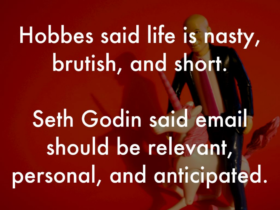My time tested and proven eCommerce email strategies that will grow your eCommerce retailer without spending $ on paid ads.
Fragility Breeds Stress
When I started my retailer back in 2003, I wouldn’t say that I was the happiest guy in the world.
Quite the opposite — my business frustrated the hell out of me.
I would devise some cool promotion or offer only to see our top competitors knock if off it the next week.
I would spend weeks figuring out a content strategy that would get us top Google ranking, implement it, and then freak out when Google changed up its ranking algorithm.
One morning I even woke up to see a carbon-copy of our site operated out of rural China.
On days like those I could actually feel my hair turning grey. Like in real time.
On the internet there are no secrets.
Everything can be seen, and if it can be seen it can be copied. Every advantage gone in a matter of time.
Woe to those who depend on a single source for all their traffic.
And all this for a piddly 1% conversion rate.
Enter: Seth Godin
 During one of these particularly frustrating weeks I downloaded Seth Godin’s Permission Marketing on audiobook. I’m not sure what initially attracted me to the book — maybe I had heard Godin speak or had found his bald head to be appealing.
During one of these particularly frustrating weeks I downloaded Seth Godin’s Permission Marketing on audiobook. I’m not sure what initially attracted me to the book — maybe I had heard Godin speak or had found his bald head to be appealing.
Whatever the reason, one weekday morning I was doing a little sprint workout, running up the Lyon Street Steps in San Francisco, listening to Godin expound on email marketing.
- First sprint up the steps: Your email list is an asset — probably one of the most valuable assets a business owns, second to only your customer list. Interesting. In a world where none of our customer acquisition channels were particularly dependable — Adwords was getting expensive, with SEO we were at the mercy of Google — a big email list would be a friggin’ rock. Something we could depend on, day in and out, to drive revenue. I liked that.
- Second sprint up the steps: Great emails should always be three things: anticipated, relevant, and personal. Personal. As in each email subscriber could potentially receive unique emails that are targeted to her and her only. As in different offers for different customers. As in a potential competitor couldn’t actually see what I was doing here because it wasn’t plastered all over the site. A good email marketing program wouldn’t only an asset, it would be a defensible one.
- Third sprint up the steps: Think of emailing like dating — you build up trust over time with your subscribers (i.e., you date them) and eventually they make a purchase (you get married).(Side note: glad he chose that kind of consummation instead of the other obvious one.) We’d been busting our ass with the standard “convert a new visitor to a customer” funnel when there was a much more promising one: “convert a new visitor to a subscriber, and then convert that subscriber to a customer.”
Maybe it was the lack of oxygen to my brain by that third sprint, but it finally hit me: email marketing was the answer.
The truth was that up until that day I really hadn’t built anything defensible at my company.
My “business” was built on a loose foundation consisting of hacks and tactics and tricks, and these things do not make for a true sustainable competitive advantage.
But email could provide that advantage.
My Email-First Business
I drove to the office that morning more excited than I had been since I started my company.
Over the next few weeks, we began to prioritize email, rolling out some basic newsletter programs and encouraging more opt-ins…
…Over the next few months, we experimented with email drip campaigns, campaigns that built up trust with our subscribers and ultimately sold more product…
…And within a year we were on to advanced email marketing: behavioral-based segmentation and targeting campaigns, all driven off a customer database and 100% automated.
Results followed. Our list size exploded. The value per subscriber — which had hovered around $1/subscriber/year in 2004 — eventually moved past $1/subscriber/month.
In 2007, when the Great Recession cut our revenue in half, revenue off that list kept us in business.
In 2008, when a disastrous Magento migration eliminated the site from Google for weeks, revenue off that list kept us in business.
And the best part? In 2011 I sold my company. The first question every potential acquirer asked?
“How big is your list?”

Why Email Will Work for You
Email works, and here’s why:
- It’s been around forever. Email has been around for 22 years. With that history, it has achieved a dominant market share — 91% of US consumers use email daily. My mother has no idea what Twitter is; she reads her email daily.
- It’s widely used. As of 2015, there were 300 million Twitter accounts. Whoopdee doo. Those accounts are like gnats on the side of the 1.4 billion Facebook accounts. But those accounts still get round-housed by the over 3 billion email accounts. Everyone has an email account.
- It’s used . . . by consumers. 75% of all email is generated by consumers. As in people who buy things. As in the average order value for an email offer is 20% higher than it is via other channels, and conversion rates are three times higher via email.
- It presents incredible targeting potential. Yes, so do some other channels, but with email you can essentially go to the extreme of “right offer to right person at right time.” That’s 1-to-1 targeting right there. And targeting is what will move your list value — your dollars per subscriber — up ten-fold.
Business happens in the inbox. Put all this together and you have one potent marketing channel. And the beauty is, you can control this channel completely.
Build a list and it’s yours to keep, to make money for you in good times and bad week in week out.
Godin is right: When it comes to building a business on the internet, there’s no better way to guarantee your success than by building up your opt-in asset.
So my recommendation to you is to focus on what you can control.
Build a list of rabid fans ready to buy your product.
You aren’t in the housewares business or the project management business or even the SAAS business or the e-commerce business…
You are in the audience-building business.
Go build your audience.
